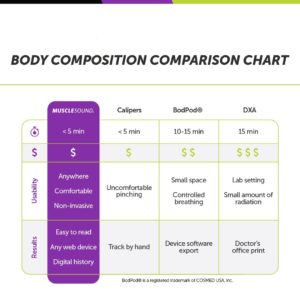The body is composed of water, protein, minerals, and fat. A two-component model of body composition divides the body into a fat component and fat-free component. Body fat is the most variable constituent of the body. The total amount of body fat consists of essential fat and storage fat.
Essential Fat is necessary for normal body functioning and is found in the following places:
- Bone Marrow
- Heart
- Lungs
- Liver
- Spleen
- Kidneys
- Intestines
- Muscles
- Lipid-rich tissues throughout the central nervous system
Storage Fat, on the other hand, accumulates in adipose tissue and is located around internal organs (internal storage fat) and directly beneath the skin (subcutaneous storage fat). It provides bodily protection and serves as an insulator to conserve body heat.
The relationship between subcutaneous fat and internal fat may not be the same for all individuals and may fluctuate during the life cycle.
Importance
Health practitioners universally agree that too much body fat is a serious health risk. Problems such as hypertension, elevated blood lipids (fats and cholesterol), diabetes mellitus, cardiovascular disease, respiratory dysfunction, gall bladder disease, and some joint diseases are all related to obesity. Also, some research suggests that excessive accumulation of fat at specific body sites may be an important health risk factor. 1 For instance, it appears that extra fat around the abdomen and waist is associated with higher risk of diabetes, heart disease, and hyperlipidemia. Individuals who accumulate a lot of fat around the waist (apple-shaped) are worse off than those who tend to accumulate fat in the thighs and buttocks (pear-shaped). The apple-shaped pattern of fat deposition is more commonly seen in men; whereas women tend to be pear-shaped.
Now, more than ever before, people are preoccupied with how much they weigh. In an effort to lose weight and excess fat, Americans spent in 1989 an excess of 30 billion dollars for 54 million diet books and for services and products at 1500 weight control clinics. 2 Yet, efforts such as these to achieve thinness are often based on popular misconceptions about body weight and body composition. Being thin does not necessarily reduce one’s health risk. In fact, obsession with becoming thin often leads to serious eating disorders such as anorexia and bulimia. Thinness simply refers to weighing less than the recommended values in age-height-weight tables. Leanness, on the other hand, refers to the muscle, bone, and fat composition of your body weight. Although some lean individuals may actually weigh more than their “tabled” ideal body weight, low body fat lessens the risk of health problems.
Understanding the difference between healthy leanness and undesirable thinness is important. In addition, there are some other reasons to become more informed about body composition:
- To develop complete physical fitness profiles
- To monitor body fat loss and muscle growth resulting from exercise.
- To provide baseline data for nutritional counseling and treatment of obesity.
- To describe changes due to growth, development, maturation, and aging.
- To maximize the performance of athletes.
Lean Body Mass
Lean body mass represents the weight of your muscles, bones, ligaments, tendons, and internal organs. Lean body mass differs from fat-free mass. Since there is some essential fat in the marrow of your bones and internal organs, the lean body mass includes a small percentage of essential fat. However, with the two-component model of body composition, these sources of essential fat are estimated and subtracted from total body weight to obtain the fat-free mass. MuscleSound is the most practical method of assessing body composition. It is based on the two-component (fat and fat-free mass) model of body composition.
This information is particularly valuable if a client is going on a weight loss diet. Oftentimes diets will result in loss of mostly lean body tissue and water. By tracking a client’s body fat you can closely monitor what body composition changes are actually happening. Just knowing how many pounds a person has lost is insufficient. The goal of any weight control program is going to involve adjusting a person’s exercise and dietary habits to reach that ideal percentage of body fat.
Body composition is an integral component of total health and physical fitness. We promote leanness, not thinness, to enhance lifetime physical and mental well-being.
- Wilmore, J. H., Buskirk, E. R., DiGirolamo, M., & Lohman, T. G. (1986). Body composition: A round table. The Physician and Sportsmedicine, 14(3), 144-162.
- McArdle, W. D., Katch, F. I., & Katch, V. L. (1991). Exercise physiology: Energy, nutrition, and human performance (3rd ed). Philadelphia: Lea & Febiger.

